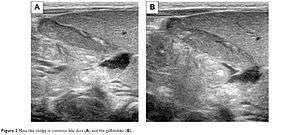Biliary pseudolithiasis

Mass-like sludge in common bile duct (A) and the gallbladder (B) in a neonate who received ceftriaxone
Biliary pseudolithiasis refers to an unusual complication of ceftriaxone where the drug complexes with calcium and mimics gallstones.[1][2] It is reversed when ceftriaxone administration is stopped.[2] It was first described in 1988 by Schaad et al. as "reversible ceftriaxone-associated biliary pseudolithiasis".[2]
See also
References
- ↑ Kirejczyk, W. M.; Crowe, H. M.; MacKay, I. M.; Quintiliani, R; Cronin, E. B. (1992). "Disappearing "gallstones": Biliary pseudolithiasis complicating ceftriaxone therapy". American Journal of Roentgenology. 159 (2): 329–30. doi:10.2214/ajr.159.2.1632349. PMID 1632349.
- 1 2 3 Schaad, U. B.; Wedgwood-Krucko, J; Tschaeppeler, H (1988). "Reversible ceftriaxone-associated biliary pseudolithiasis in children". Lancet. 2 (8625): 1411–3. doi:10.1016/s0140-6736(88)90596-x. PMID 2904533.
This article is issued from Wikipedia - version of the 6/21/2016. The text is available under the Creative Commons Attribution/Share Alike but additional terms may apply for the media files.